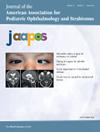儿童双侧白内障手术:立即顺序手术与延迟顺序手术。
IF 1.2
4区 医学
Q3 OPHTHALMOLOGY
引用次数: 0
摘要
目的:比较一组接受过延迟性双侧白内障连续手术(DSBCS)或即刻性双侧白内障连续手术(ISBCS)患者的眼部和麻醉相关并发症:方法:回顾性审查了 2012 年至 2021 年期间在我院接受双侧白内障手术的儿童病历。纳入的患者年龄为 0-24 个月、无晶体眼、术后随访至少 1 年:结果:共纳入 56 名儿童:结果:共纳入 56 名儿童:23 名接受了 ISBCS;33 名接受了 DSBCS。ISBCS 患者手术时的平均年龄为 2.6 ± 2.5 个月,DSBCS 患者手术时的平均年龄为 2.8 ± 3.0 个月(P = 0.752)。ISBCS组患者更常见全身性疾病。ISBCS 组每个患儿的平均麻醉时间更短(P < 0.001),但两组的平均手术总时间相似。两组术中麻醉相关并发症和眼内并发症的发生率相似。没有眼内炎病例。两组患儿在一年内接受额外手术治疗的平均次数和复诊的平均次数相似。ISBCS组患儿需要住院的天数较少(P < 0.001):结论:与 DSBCS 相比,ISBCS 不会增加眼部或麻醉相关并发症的发生率。ISBCS 避免了重复麻醉,缩短了患儿的总麻醉时间。本文章由计算机程序翻译,如有差异,请以英文原文为准。
Bilateral cataract surgery in children: immediate sequential versus delayed sequential surgery
Purpose
To compare ocular and anesthesia-related complications in a cohort of patients having undergone either delayed sequential bilateral cataract surgery (DSBCS) or immediate sequential bilateral cataract surgery (ISBCS).
Methods
The medical records of children who underwent bilateral cataract surgery at our institution between 2012 and 2021were reviewed retrospectively. Included patients were 0-24 months of age, aphakic, and followed for at least 1 year after surgery.
Results
A total of 56 children were included: 23 underwent ISBCS; 33, DSBCS. Mean age at surgery was 2.6 ± 2.5 months for ISBCS patients and 2.8 ± 3.0 months for DSBCS patients (P = 0.752). Association with systemic diseases was more common in the ISBCS group. The mean anesthesia time per child was shorter in the ISBCS group (P < 0.001), although the mean total procedure time was similar in both groups. The rate of intraoperative anesthesia-related complications and intraocular complications was similar in both groups. There were no cases of endophthalmitis. The mean number of additional surgical interventions per child and the mean number of follow-up visits within 1 year were similar between groups. Children in the ISBCS group required fewer nights of hospital admission (P < 0.001).
Conclusions
ISBCS in children in this series did not lead to an increased incidence of ocular or anesthesia-related complications compared with DSBCS. ISBCS avoids repeated anesthesia and shortens the total time that the child is under anesthesia.
求助全文
通过发布文献求助,成功后即可免费获取论文全文。
去求助
来源期刊

Journal of Aapos
医学-小儿科
CiteScore
2.40
自引率
12.50%
发文量
159
审稿时长
55 days
期刊介绍:
Journal of AAPOS presents expert information on children''s eye diseases and on strabismus as it affects all age groups. Major articles by leading experts in the field cover clinical and investigative studies, treatments, case reports, surgical techniques, descriptions of instrumentation, current concept reviews, and new diagnostic techniques. The Journal is the official publication of the American Association for Pediatric Ophthalmology and Strabismus.
 求助内容:
求助内容: 应助结果提醒方式:
应助结果提醒方式:


